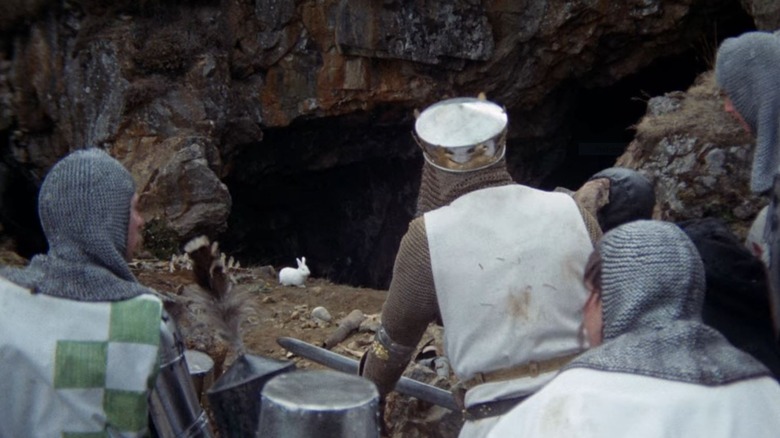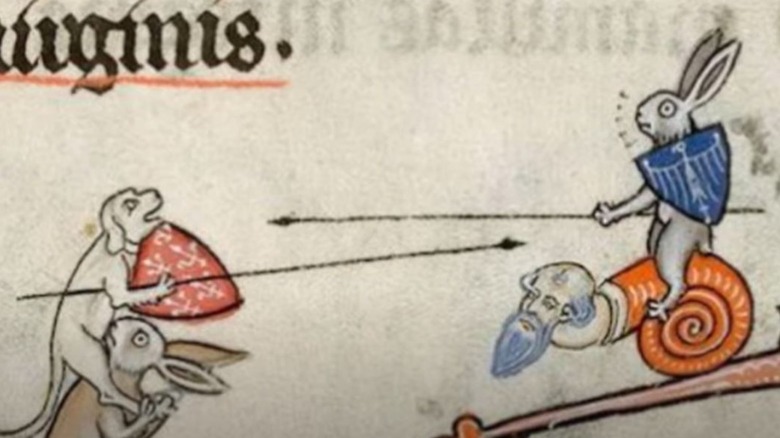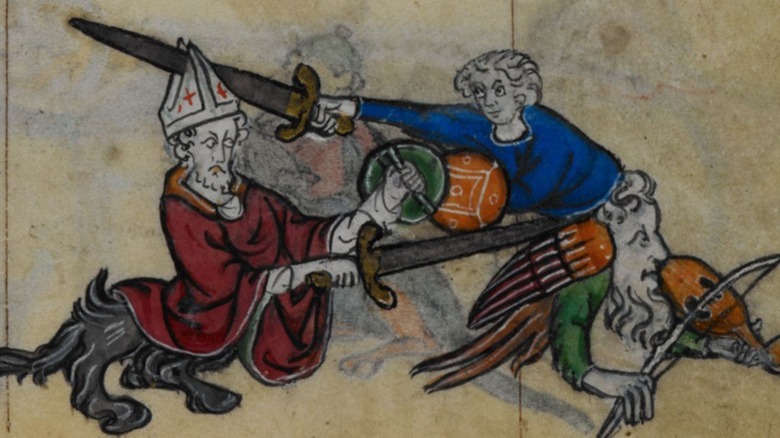The Bizarre Medieval Paintings Of Rabbits Explained
"Death awaits you all with nasty, big, pointy teeth!" If you recognize that line from 1975's "Monty Python and the Holy Grail," then you can congratulate yourself on your excellent taste in cinema. In that scene, Tim the Enchanter (played by John Cleese) warns King Arthur and his crew (the Monty Python guys) about their upcoming doom in their quest for the Holy Grail. The nasty, deadly-toothed creature he's talking about? A little white bunny. And to be sure, the bunny monster at the Cave of Caerbannog lives up to its reputation as a gore-slaked slayer of men.
But did you know that this seemingly random choice of a foe, chosen for comedy's sake, is actually a reference to old medieval paintings? Yep, it seems that the English sense of humor hasn't changed much in, oh, about 800 to 600 years. Back in the 13th to 15th century, per Ancient Origins, a common form of comedy arose in the margins of manuscripts: drolleries. Drolleries — far more interesting than the word "droll" implies — were basically tiny comic strips drawn by what we assume were some bored monks. Monks were the original printing press, after all, copying, binding, illustrating, and inscribing entire books one at a time in rooms called scriptoriums. And let's be clear: They were just as imaginative and twisted as us. We've got comics of giant snails fighting knights, monkeys blowing flutes up the butts of other moneys, and of course, hyper-violent rabbits.
Rabbits, unicorns, and flying genitalia, oh my
Murderous rabbits were indeed a favorite of medieval copyists, and anthropomorphism — animals behaving like people — was a recurring theme. In one image on Ancient Origins, we've got rabbits defending a tower from a siege from dogs. Both sides have shields, the dogs have swords, and the rabbits are throwing what is either white, clumpy stones or colorless poo at the dogs. In another image on Open Culture (pictured above), we've got a rabbit jousting another rabbit. One of them is riding a dog, the other one a, uh ... white-bearded, half-man, half-snail creature. In others, rabbits are straight up torturing, capturing, or murdering people.
Rabbits were just one of a host of creatures pulled from real and imagined bestiaries (compendiums of beasts) for use in drolleries alongside humans. Deer, birds, dragons, unicorns, men mooning the reader, flying penises ridden by naked women, a disembodied penis in a basket — plenty of drolleries were rated "R" for "really?" As author Jon Kaneko-James' website says, "Drolleries sometimes also depicted comedic scenes, like a barber with a wooden leg (which, for reasons that escape me, was the height of medieval comedy) or a man sawing a branch out from under himself." Was a similar scene also in one of Terry Gilliam's animated interludes from "Monty Python and the Holy Grail"? Indeed, nearly all of Gilliam's work in the film looks like it was inspired by the style and content of drolleries.
Monks needed to de-stress at work
So why rabbits? Well, because people view them much like way we think of rabbits today: pure, helpless little creatures. Pitting them against humans or imbuing them with murderous qualities was all the more ridiculous. As Open Culture explains further, quoting Jon Kaneko-James, "This enjoyment of the 'world turned upside down' produced the drollery genre of 'the rabbit's revenge,' one 'often used to show the cowardice or stupidity of the person illustrated.'" In real life, rabbits were often the hunted victims of people, wolves, etc. In comics, though? They could get their revenge. Monks who drew such drolleries were making fun of big burly brutes, changing them into "tough hunters cowering in the face of rabbits with big sticks." The Middle English nickname "Stickhare," in fact, meant "coward."
It wasn't just the big and tough who were targeted by monkish humor — nuns and other clergy were razzed, too. One drollery on Ancient Origins shows a monk playing some kind of fiddle while a nun-looking lady dances with a higher-than-usual skirt. Sex and erotica, as described previously, were also common drollery themes. Unsurprisingly, rabbits were connected to this for the same reason they're modernly connected to sex: They produce lots of offspring. Sometimes, monks even left notes in the margins, sounding like bedraggled workers at the end of a shift. "Thank God, it will soon be dark," one wrote, and another, "Now I've written the whole thing: For Christ's sake, give me a drink."


